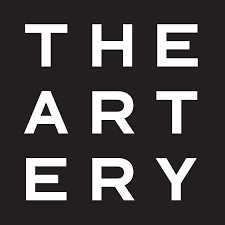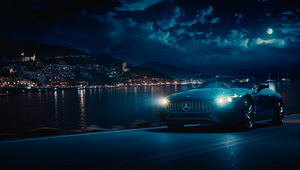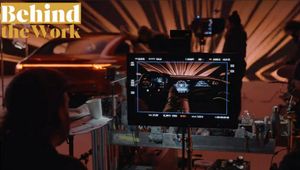
Bridging the Gap Between Film and Commercial Work

As the lines between entertainment and advertising blur, we have seen a rise in cinematic quality across commercial work. At The-Artery, artists and producers move between both, applying specialist knowledge across both crafts to elevate work even further.
To explore how this shapes their capabilities and output, in this interview LBB speaks with The-Artery CCO and founder Vico Sharabani, executive creative director / head of 2D Elad Offer and creative director / VFX supervisor Yuval Levy who open up on how film and commercial work drive each other forward, and highlight some of their best projects to date.
LBB> At The-Artery, producers and artists work across both film and commercial work. How does one help drive the other and vice versa?
Vico> Our artists are well-versed on the speed of the commercial world and the quality and realism of feature film work. Having them master both types of work, elevates their capabilities no matter what the job requires.
Elad> Working across mediums gives us a unique view of what tools we can use at what time and allows us to deliver high level work across the board. We aren't as stuck to one approach or to one process as some companies can get. When we see a tool that's normally used on features but fits a specific task on a commercial, or vice versa, we'll just use it and our system is built to be flexible enough to allow for that.
Same goes for our artists. Because we use a wide range of artists that are either highly specialised or more generalist in nature we can be more nimble in matching the skills to the task.
Yuval> The quality that we produce in our features work, in terms of realism and the methodology that we have developed for this long-form work is transferable to our commercial projects. The flip side is that the speed at which we problem solve in commercials and how fast we have to have creative and technical solves due to the tight advertising space, can be ported in our film work.
From our partnerships with movie directors we develop a shorthand over those longer engagements. This becomes massively helpful in short-form where we have to quickly work our way to creative solutions. The experiences we gain from features can generally be applied or borrowed or cherry picked for commercials and the way we craft images for the big screen can be parsed out. The level we need to reach for a film is not something we can unlearn for a commercial - the quality remains, we don’t have tiers.
LBB> What is something that you personally love about working on films?
Elad> The experience of watching a movie, especially in the movie theatre is really incomparable in my opinion. Especially on well-made movies, and we've been lucky to work on quite a number of those, it leaves you with an experience that's really unparalleled and transports you to different places and times like nothing else. The impact one can make long-term is also quite different on a feature film than on a commercial. When you work on a feature you know it'll stick around for years, sometimes even decades. Just last week I was able to show my 10 year old daughter a sequence I supervised on "Get Smart" all the way back in 2008 and not only did it still hold up, she got a huge kick out of it. That's something that's much harder to get out of a commercial.
Yuval> Unlike a commercial that sells a product, the movie is the product and we’re charged with creating the visual cues that help drive the story. It also affords us the opportunity to work closely with amazing top shelf directors and learn from their experience. Typically, these directors have a heightened sensitivity for VFX and we carry that forward with us, the finesse, the care and the fact that we have to scrutinise the full gamut of creative approaches is so valuable for us and we bring this to our commercial work.
We are fully fledged creative partners in the features process, playing a huge role in conceptualising and determining how the VFX will look.
LBB> Can you tell us about your favourite film projects?
Elad> Last year we worked on James Gray's "Armageddon Time" which was a real pleasure to work on. Not only is James a true artist and auteur, but I was incredibly touched by the story and by being allowed to play such a big role in what was very obviously a very personal story for him and a story with such an important message to boot. On the complete other end of the spectrum was working on "Magic Mike's Last Dance" for Stephen Soderbergh which was not only technically complex but ummm... visually exciting.
Yuval> Smile is a personal favourite of mine, working on the project was an amazing adventure. We thought we were booking a relatively small production destined for a streaming service, but what we got was a huge theatrical release in which we partnered with first time director Parker Finn which became a number one box office hit.
LBB> And what is it that you most love about working on commercials?
Vico> We have vertically integrated the process of creative through execution and delivery in the commercial workflow. This gives us unique freedom and control over commercial projects.
Elad> I love the speed and ingenuity that comes with pretty much all commercial advertising work these days. There is usually so much to do in such a short time frame that it really takes a ton of creative problem solving which I really enjoy.
Yuval> I get to don my director’s or CD’s hat, exercising my creative muscle and the speed at which we have to work can be quite exhilarating. We can often exceed the expectation set by the budgetary or schedule constraints and the flexibility and sheer variety of work in commercials is a great sandbox to play in.
LBB> What are some of your favourite commercials you have worked on?
Elad> The Mercedes spots Yuval and I directed for the PGA Masters tournament were really fun to work on and allowed us to incorporate all the latest tricks including working on one of the biggest XR stages in California. Prior to that, it was a Nike spot I creative directed for Paul Hunter many years ago where we combined dozens of artists shot all over the world into one training environment.
Yuval> I’ve acted as director on commercials for both Mercedes and Nascar and these are the spots that hold the most special place in my heart.
LBB> What are some of the learnings you’ve taken from film work that you’ve applied to your commercial work? And what about the other way around?
Vico> We have taken workflow, CG and colour pipeline, as well as the QC process from the film world and applied it to the commercial workflow. We take the agility and speed we apply to our commercial work, and the unique, high-level experience of live-action commercial production and bring this to our film work wherever might be necessary... For instance we can bring our efficient production experience to bear when producing plates for our film projects.
We also often use feature film DPs on our commercial projects, so the relationships tend to cross pollinate our production crews as well as the post and VFX workflows.
Elad> The biggest thing I've taken from film work is how to work in an organised way with a large team and a precise gameplan going into a project. This has helped us at The-Artery handle huge complicated projects with quick turnarounds and without a lot of the chaos that can creep into such projects. Well that and colour science - I've had to learn the ins and outs of the colour pipeline when working on features and with HDR starting to get into commercials, it's been really helpful know-how to have.
From commercials I've learned how to keep my cool (well mostly) and deal with twists and changes under stressful deadlines and how to come up with quick creative solutions to complex problems.
Yuval> Learning from world class DPs, art directors, set designers, FX teams, stunt coordinators and the biggest film production companies in the world like A24, Disney, MGM, Paramount, Apple and Netflix who set an especially high standard and who expose us to cutting edge technical approaches and production environments, this all raises our game.
This exposure also helps us in learning where to rein in the VFX and allow the practical FX take the lead, we don’t look to make VFX prominent we only seek to serve the story, so if this can be done in camera, fantastic.
LBB> How does this multifaceted talent across both crafts benefit your clients?
Vico> The benefit for our clients is the learnings we have from the diversity of our work across all mediums (film, commercial, and tech) which results in a deeper and broader appreciation for the ‘beautiful pixels’ in each project. We bring varied perspectives and appreciation for the multiple languages of each medium and a deeper understanding of how to develop the greatest impact for the project...
Elad> Working across multiple genres and formats means that we have to keep agile and at the very forefront of all the latest innovations and technologies which is obviously helpful to our clients but the involvement in long-form projects constantly reminds us at The-Artery that at the end of the day our work is in the service of the story and if we help tell a good story, we'll have provided our clients the best possible service.
It doesn't matter if it's a movie, TV show or commercial, all the technology is useless if it doesn't tell the right story, the story that our clients are trying to tell, that's a lesson that I feel like it's easier to remember when you work across a wide range of genres.
Yuval> The experience we have in both disciplines are similar but by no means apples for apples, however, we adapt the experience we gain and have learnt how to effectively apply very focused aspects of each from one to another discipline. For example, in features we learn how to truly craft every frame. We translate this into our approach for commercials, which typically have a much shorter turnaround and then the fast paced processes we develop in commercials can be upcycled into efficiencies in our features work.
LBB> Anything else to share?
Elad> Technically speaking the worlds of long-form and short-form, of feature film and TV or even socials are combining - 4k renders, HDR, complicated VFX are becoming common across the board but the production experience and timelines still remain very different. We believe that working across the genres forces us to be agile in a way that benefits the process and our clients. As our CCO likes to say, to do creative work in creative ways. We always like a challenge!
Yuval> I feel that we are bombarded with an overwhelming amount of visual content, we constantly strive to produce innovative and exciting solutions to help tell the stories we’re working in that captivate our audiences and transport them.
At The-Artery, we’re always seeking to push the boundaries and this out-of-the-box thinking is what provides us with the most creative nourishment. This is the exciting stuff that draws creatives to the industry and separates us from the bankers...










